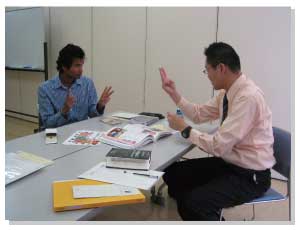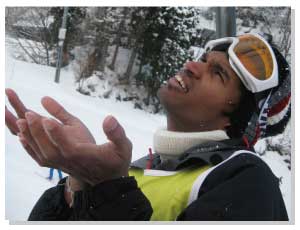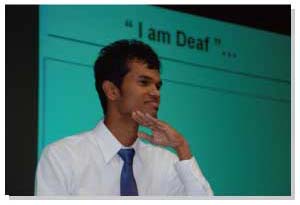- HOME
- Alumni News
- Kasun Chandana Jayathunga (10th trainee)
- Kasun's Final Report
Kasun's Final Report
Through new experiences, I became a new deaf person
The objective of my training
1. Improving education for the deaf: When I worked as an ICT teacher at Rohana Special Deaf School, I found out that many deaf school teachers in Sri Lanka were at a disappointing level in sign language fluency. And almost all of them used the simultaneous communication (“Sim-Com”) approach in which they spoke at the same time as communicating in sign language. This approach is very confusing for deaf pupils. As a result the pupils cannot get to higher education and many of them leave school before Original Level Exam by age is 16. So I wanted to learn about general deaf education and pre-school education in Japan, especially teaching styles, language development methods & techniques, and about visual aids such as Powerpoint.
In addition, I was engaged in RUHUNU SUMAGA Circle of the Deaf (RSCD) Association In Sri Lanka. So I wanted to know how to approach deaf movement efficiently, and also learn about deaf organizations’ networking system.
Japanese Language and Sign Language Training
During the first three months, I studied Japanese and Japanese sign language. Japanese grammar was so interesting. I felt it was easier to remember and write than English. Also I loved learning and reading kanji because there were a lot of concepts behind it. I will never forget Ms Sato’s teaching style and technique. All our teachers were very professional and taught me kindly. As for the sign language, it was very difficult to communicate in Japanese sign language, or to memorize JSL signs. Since childhood, I had only learned speech rehabilitation and never a sign language. I started to learn sign language at age 25 when I became a member of RSCD. So at the beginning in the JSL class, I felt it was really difficult to switch my brain from thinking in phonetics, to thinking in signs. But finally I managed it, so I am really thankful to my JSL teachers and Yee Haw who was also a Duskin trainee. He kindly taught me.

Ski trip and swimming
We went to Niigata Prefecture for a ski training. This was the place where I felt I was really alive. Actually, playing with the snow was beyond my imagination. I had never seen snow before. This was the first time that I touched snow with my hands. I enjoyed the snow very much. My ski teacher helped me ski down the high mountain. It was great fun and an unforgettable time for me.

Another sport is swimming. Our swimming teachers were very professional and kindly taught me. Their swimming instruction techniques were excellent. The result; now I can control my body and soul in the water by myself, like fish. I got a hang of it and it was a lot of fun.
Home Stay
I went to Kagoshima to home stay with the Hokazono family. Shinichi san, his wife Satsuki san, and their cute son and daughter were all deaf and it was really amazing to meet them because I had never had any experience with a deaf family or deaf family culture. They were very kind and cheerful. Shinichi san and his wife took me to visit many different places in the area and entertained me. For the first two days we all went to the house of Satsuki san’s mother. I was really happy helping Grandmother and Grandfather in their big paddy fields. It was such hard work, but it was also a great experience. I felt like a Japanese farmer. I was happy and I enjoyed the stay. I had many good days with them. I really miss and love them & I would like to thank them a million times.
Individual Training.
1. NPO-Japanese ASL Signers Society
I had only 8 days, a very short period of training there, but I had lots of memories and also challenges. It was the best training site for me as it gave me a chance to rethink who I was, what sign language meant for me, and what the deaf culture was. It had very useful and important effects on me. I studied presentation skills and methods by using sign language and how to create Powerpoint presentations effectively. Also I learned about report-writing (e.g. Add feelings, challenges and positive thoughts). These activities were successful with the guidance by Kumiko san and Seiko Omori-san. I learned many things, including many positive thinking and challenges. I am really grateful to all of them.
2. Japanese Deaf Education
I visited many deaf schools in Japan during my individual training. I found out that there were many teachers who used sign language one way or another in classrooms. My final training place was Meisei Gakuen. It was only for five days, a very short period of time. Meisei Gakuen’s bilingual education supports acquisition of two languages, JSL and Japanese. They teach only reading and writing in visual methods, but not listening or speech. I was surprised to see that little children always communicated with me and asked me many questions. At the age of 0-2 in the infant class and 3-5 in the kindergarten, they were able to use sign language very quickly. I was surprised that in kindergartens for the deaf, children between the ages of 3 to 5 were able to read and write Japanese. I am really grateful to Ono Sensei for giving me a variety of information about bilingual education technique during the short 5-day period.
I also attended a training program at Tokyo Metropolitan Chuo School for the Deaf under the guidance of Mr. Hashimoto and other teachers. I saw their new wonderful technologies. Every classroom had a plasma display panel (PDP), the IR system for auditory support, visible writing information and other devices, to ensure deaf students obtained information without failure. Teachers were also putting a lot of thoughts into instruction methods, to make sure that deaf students could understand every bit of the classroom material.
At Tsukuba University of Technology, I learned about the program of the practical use of hearing ability including how to fit a hearing aid, its guidance program, and how to manage one’s own hearing aid. This was an amazing experience for me. I also attended Mr. Osugi's lectures about deaf driving license and the history of deaf people’s movement, which was very important for me to understand. Because deaf people are still not allowed to have a driving license in Sri Lanka.
3. Kumamoto Association of the Deaf
I spent 3 weeks in Kumamoto Information and Communication Center to learn about sign language DVD creating methods. I learned about videographer techniques, editing video clips, adding subtitles to video clips etc. in their production lab. Finally I made a sample of Sri Lankan sign language DVD with their production team. Now I can make a DVD by myself. Also I attended President of Matsunga san`s sign language interpreter training class. I learned the theory and had practical lessons & learned methods for sign language, had individual and group sign practice, and studied sign language interpreter books and CDs. I am thankful to all of the staff of Kumamoto Association of the Deaf and Kumamoto Information and Communication Center, who supported me in many ways and shared their experience with me.
4. Japanese Federation of the Deaf & Osaka Federation of the Deaf
I learned from the staff at the seminar of Japanese Federation of the Deaf about Japan's deaf movement and the welfare system concerning the deaf, that there are many deaf associations that have been developed and organized in Japan. I also saw that deaf associations are managed very professionally in Japan. I visited different kinds of social welfare systems in Osaka, Kobe and Awaji. There was plenty of accessibility to information, technology and services. It is really easy for older deaf people to get around, they could bring interpreters wherever they needed by appointment. Also I was given an orientation of the facility, its services and how they send out sign language interpreters. The organizations in Osaka and Kyoto exchange information. Their committees communicate with each other to work in collaboration. I realized that deaf associations were managed very professionally in Japan.
My goals after returning to Sri Lanka
- There are only five sign language interpreters in Sri Lanka. Family members, friends, volunteer themselves serve as interpreters. But as they are not professional, they often make mistakes in translation. So persons with hearing impairments cannot feel at ease in everyday life. So I have a powerful dream to create a video production lab in our deaf association of RSCD and then create a sign language training DVD, drama DVD & deaf news DVD and more. Also I would like to create sign language textbooks, magazines and newspapers to improve sign language skills for deaf school teachers, sign language classes and other hearing communities including the Government and Private Office.
- I would like to establish pre-school educational units with bilingual education philosophy and create bilingual & bicultural textbooks & DVDs. Also I hope to create a basic sign DVD for deaf infants, elementary school children and their parents. These are all very important for deaf children.
New experience―New challenge-―New person.
In Sri Lanka, I had never been to a deaf school, but regular schools. It means that I was grown up in hearing culture. So my communication was lip reading and speaking. When I was 13-25 I really disliked sign language, the reason was that strangers saw deaf people communicate in sign language and then copied them, they mimicked them, pointed at them and called them stupid. I was really shocked, embarrassed and mortified. They were making fun of them. It was stressful to take it all in.
After I came to Japan, for the first 3 months of the Japanese Sign Language education period, it was really difficult in the beginning to understand and learn various signs and think in the sign mind. I had forgotten many signs. My brain had been tuned to lip-reading and my dominant & mother language was speaking. So for the first two months it was not easy to make deaf friends, communicate with or understand them. I felt very lonely. However, finally my JSL teacher Sueki sans said, if this continued for a long time and I could not master the sign language, I would not be able to get much information, make good friends, or build a good communication network in Japan during the individual training. So I decided to prepare myself for the individual training, and fully focused and made efforts to learn the sign language and started to challenge my mind and brain, to switch from speaking to signing. Finally I succeeded. No longer did I need my hearing aids or writing pads and I could communicate with my deaf friends very smoothly. I easily felt that the sign language was a much faster communication medium more than pronouncing difficult vowels. Now, I am a new person. I learned lot about deaf culture. My heart opened…my mind opened… and my hands opened. I have confirmed that I am a deaf person. Sign language communicating is very smooth and it helped me become more aware of the deaf culture. I would like to utilize sign language communication and knowledge of deaf culture, spawned from my new challenges, when I go back home.
Finally
I would like to thank Duskin Ainowa Foundation and all the staff of JSRPD (especially kind Nasu san) who were always thinking about our needs, and all other related organizations, for their great efforts in making my training and my stay in Japan a successful and meaningful experience.





